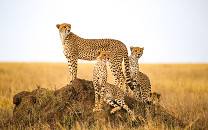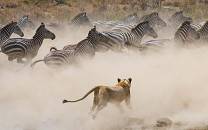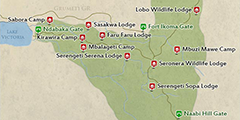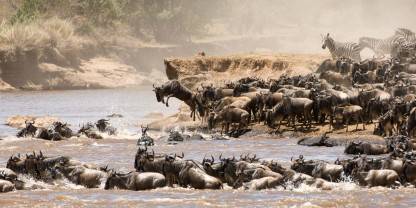The focus of most safaris in northern Tanzania, Serengeti National Park is renowned as the arena for the world’s greatest mammal migration. Even away from this iconic wildlife spectacle, the Serengeti’s sheer density of animals makes for incredible wildlife viewing throughout the year. The southern plains near Seronera are the most popular, but it’s also worth exploring the Western Corridor and Mara River regions.

-
Best Time To Go
- January to February and June to October (Different areas are best at different times)
-
High Season
- July to March (The Seronera area is crowded)
-
Size
- 14,763km² / 5,700mi²
-
Altitude
-
1,140-2,099m /3,740-6,886ft
 View Photos
View Photos
 View Photos
+24
Photos
View Photos
+24
Photos
 Open Map
Open Map
Pros & Cons
- Annual (January to October)
- Top wildlife viewing all year round
- Endless plains feel like authentic Africa
- Superb for spotting predators
- Excellent mid-range and luxury lodges
- Hot-air balloon safaris
- The Seronera area is usually crowded
- It gets very crowded at the Mara River crossings
- The exact timing of the migration is unpredictable
The Wildebeest Migration
The annual great migration comprises more than 2 million wildebeest, zebra and gazelle traveling an 800km/500mi loop across the of the Mara-Serengeti ecosystem. Most of the migration takes place in the Serengeti, which is far larger than Kenya’s Masai Mara National Reserve.
Wildlife
The Serengeti supports an incredible abundance and diversity of wildlife, from the Big Five (although black rhino is rarely seen) to giraffe, cheetah, spotted hyena, black-backed jackal, warthog and a huge variety of antelope. The Grumeti and Mara Rivers are home to grunting hippos and gigantic prehistoric-looking crocs, known for their feeding frenzy during the annual wildebeest river crossings.
More about Serengeti's wildlifeScenery
Serengeti’s immense landscape is simply stunning. This big-sky, untamed wilderness is renowned for its grassland plains punctuated with rocky outcrops (koppies) in the southeast. The Western Corridor follows the Grumeti and Mbalageti Rivers with associated toward Lake Victoria, while the Lobo Hills area is characterized by big granite boulders reaching up in the sky. Farther north the Mara River sets the scene for the infamous river crossings, the ultimate highlight of the wildebeest migration.
Activities
in Serengeti are highly productive. Depending on your program, you can structure the day around two separate game drives (morning and afternoon) or go out for a full day with a picnic lunch. Budget permitting, you could mix it up with a hot-air balloon safari. Who doesn’t want to experience the Serengeti from the sky? After landing, you’ll be treated to a champagne breakfast in the bush. Night drives and guided walks are also offered at some camps and lodges.
Weather & Climate
It’s seldom hot in the Serengeti. At around 27°C/81°F, daytime temperatures are usually pleasant, but it can get chilly at night. You’ll need warm clothing for early morning game drives. It rarely rains during the Dry season (June to October). Rain is unlikely to interfere with activities, except from March to April, the peak of the Wet season (which runs from November to May).
More about the weather and climateBest Time To Visit
The Serengeti can be visited throughout the year. However, certain areas are better at certain times. January to February is the timing of the wildebeest calving in the Ndutu area. Around June and July is when the migration is in the Western Corridor, and August and September are the best months for catching the wildebeest crossing the Mara River. Wildlife viewing in the Lobo area peaks around August and September.
More about the best time to visit



